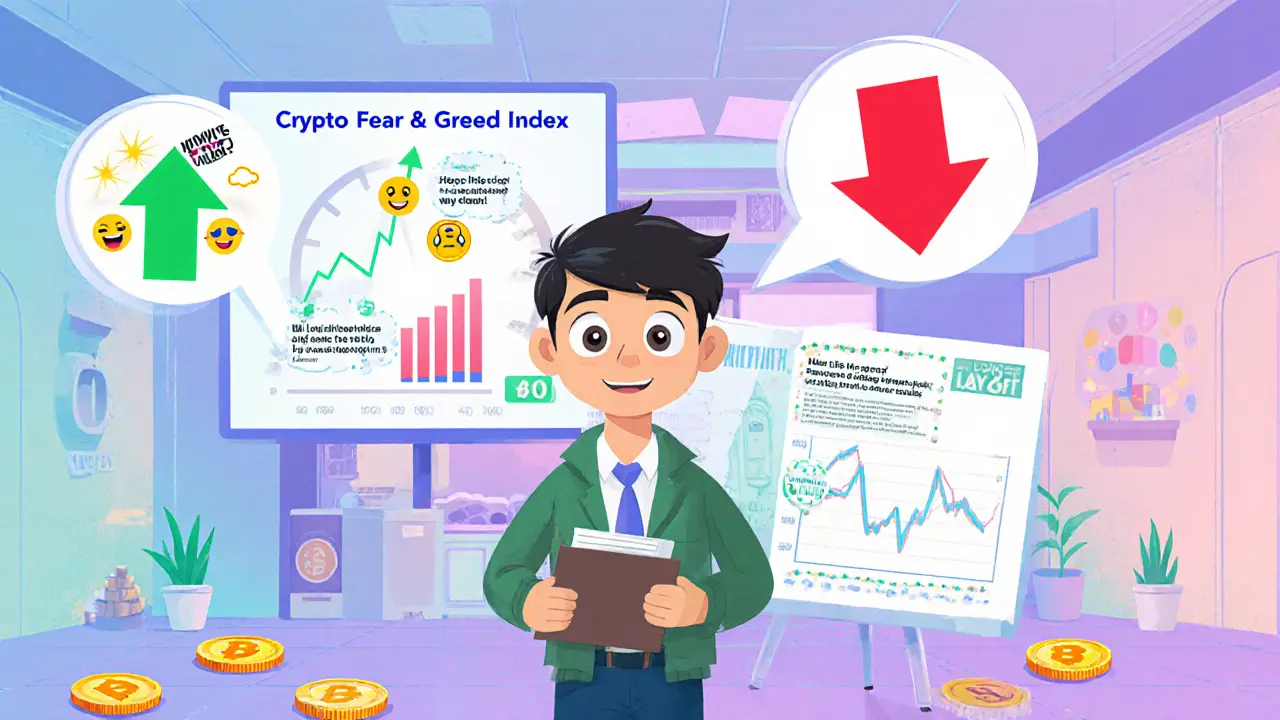Crypto Market Cycle Calculator
Current Investment Analysis
Strategy Recommendations
Set clear exit points (e.g., 30% gain) during bull runs
Use dollar-cost averaging (DCA) during bear markets
Park capital in stablecoins during bear markets
Bull Market (Cryptocurrency) is a period when most crypto investors are buying, demand exceeds supply, and prices climb steadily. In contrast, a Bear Market (Cryptocurrency) is a phase of prolonged price declines, heavy selling pressure, and low investor confidence. Understanding these two cycles is the first step to surviving the wild swings that make crypto feel like a roller‑coaster.
What really defines a bull market in crypto?
When you hear the term bull market crypto, think of a crowd of buyers pushing prices higher. The classic rule borrowed from traditional finance is a 20% rise from the previous low, but crypto often doubles that in a single day. A typical bull run might see a 40% jump in 24-48 hours, especially for smaller coins that react to a few large trades.
Key signals include:
- Rising Crypto Fear & Greed Index scores - usually above 60, indicating optimism.
- Spiking Trading Volume across multiple exchanges.
- Positive media headlines and influencer hype.
During a bull phase, new participants flood in, projects secure fresh funding, and even stablecoins see inflows as traders park profits for short‑term moves.
How do we spot a bear market in crypto?
A bear market feels like a slow, steady drain. Prices fall 20% or more and stay low for weeks, months, or even years. In crypto, the drop is often steeper - 50% to 90% for major coins, and altcoins can lose up to 90% of their peak.
Typical bear‑market clues:
- Crypto Fear & Greed Index plunges below 30, signaling fear.
- Trading volume contracts, especially on smaller exchanges.
- Media tone shifts to skepticism; many projects announce layoffs or pauses.
The December 2017 crash is the textbook example: Bitcoin slid from about $20,000 to under $4,000 in weeks, and altcoins melted even faster. That period taught the community that optimism can evaporate in a heartbeat.
Technical traits that set the two cycles apart
Both phases have distinct price‑action patterns, volume behavior, and sentiment shifts.
| Attribute | Bull Market | Bear Market |
|---|---|---|
| Typical price move | +20% to +200% (often +40% in 1‑2 days) | -20% to -90% |
| Duration | Weeks to several months | Months to years |
| Trading volume | High and rising | Low and declining |
| Investor sentiment | Optimistic, FOMO | Pessimistic, risk‑averse |
| Media coverage | Positive, hype‑driven | Negative, cautionary |
Notice how volume is a reliable early‑warning sign. A sudden surge often precedes a bull run, while a sustained dip hints at a bear market taking hold.

What major players say about the cycles
Coinbase’s education hub stresses that both bull and bear markets offer distinct opportunities. During a bull run, they advise setting profit‑taking targets, while in a bear market they suggest using dollar‑cost averaging (DCA) to accumulate at lower prices.
Analysts at 101 Blockchains note that bull phases tend to follow a predictable rhythm: after a deep correction, prices stabilize, then speculative enthusiasm builds, leading to a rapid climb.
Cointelegraph highlights that crypto bull runs are usually more intense than those in stocks, meaning traders need crypto‑specific risk tools.
How everyday investors can act in each phase
During a bull market:
- Set clear exit points - decide in advance when you’ll take profits (e.g., 30% gain).
- Watch the Fear & Greed Index - extreme greed (>80) may signal a top.
- Avoid adding too much new capital once prices are soaring; the risk of a pull‑back is high.
During a bear market:
- Stay patient - it can take months for the market to find a floor.
- Use DCA to slowly build a position in high‑quality assets like Bitcoin or proven Altcoins.
- Shift a portion of your portfolio to Stablecoins to preserve capital while waiting for better entry points.
- Focus on fundamentals - projects that keep developing despite price drops are more likely to survive.
Both phases reward disciplined investors. The key is to treat optimism and fear as data points, not drivers of your decisions.

Future outlook: Will cycles become milder?
As institutional money flows in, analysts expect crypto cycles to smooth out a bit. Larger market caps mean price swings won’t be as dramatic as the 2017‑2018 era, but volatility will remain higher than traditional assets.
Regulatory news also acts as a catalyst. Positive rules can launch a bull run, while harsh restrictions can accelerate a bear market. Staying aware of policy shifts is therefore part of any solid strategy.
Quick cheat‑sheet for navigating crypto markets
- Watch sentiment: Fear & Greed Index, social media buzz.
- Check volume: Rising volume = bull, falling = bear.
- Set targets: Profit‑taking in bull runs, DCA in bear phases.
- Focus on fundamentals: Development activity, team credibility.
- Stay liquid: Keep a portion in stablecoins for quick moves.
Frequently Asked Questions
What percentage move defines a bull or bear market in crypto?
While traditional finance uses a 20% move, crypto often sees 40% jumps in a day for bull runs and 50‑90% drops for bear markets.
How reliable is the Crypto Fear & Greed Index?
It’s a useful gauge of collective sentiment, but you should pair it with volume trends and on‑chain data for better accuracy.
Can I profit in a bear market?
Yes. By buying quality assets at deep discounts, using DCA, and holding until the next bull cycle, many long‑term investors have turned losses into gains.
Is Bitcoin the only safe bet in a bear market?
Bitcoin usually holds the highest market‑cap and liquidity, making it relatively safer, but well‑tested altcoins with strong development teams can also survive downturns.
How long do crypto bear markets typically last?
Historical data shows bear phases lasting anywhere from six months to three years, depending on macro‑economic conditions and regulatory news.
Should I follow influencers for market timing?
Influencers can highlight trends, but their timing is often off. Base decisions on data-volume, sentiment indexes, and on‑chain metrics-rather than hype.
What role do stablecoins play during a bear market?
Stablecoins act as a parking spot for capital, allowing you to avoid further losses while staying ready to re‑enter when prices stabilize.

13 Comments
Daisy Family
lol so you're telling me crypto isn't just a glorified casino with more charts? 🤡 i mean, if you need a 12-page guide to know when to buy or sell, maybe you shouldn't be touching this shit in the first place. #fomoisnotastrategy
Paul Kotze
Actually, the Fear & Greed Index is decent but it's way more reliable when you layer it with on-chain metrics like NVT Ratio or MVRV. I've seen it spike to 85 while BTC was still in accumulation mode - classic trap. Volume confirms the signal. Don't just trust the index, pair it with real data.
Jason Roland
I used to panic-sell in bear markets until I started DCAing every Friday with $50 into BTC and ETH. Three years later, I'm up 4x. It's not sexy, it's not a get-rich-quick scheme - but it works. The market doesn't care if you're emotional. It just moves. Stay consistent.
Niki Burandt
i mean... if you're still buying altcoins in a bear market without checking their github commits, you're basically donating to dev wallets 😘💕 just saying. also, stablecoins are your best friend right now. don't be that person who lost 90% because they "believed in the vision" 🤦♀️
Chris Pratt
in my culture, patience is sacred. crypto is no different. if you rush, you lose. if you wait, you learn. the market will always come back - but only if you're still standing when it does. 🙏
Karen Donahue
This whole post is just Wall Street jargon repackaged for crypto bros. You say 'dollar-cost averaging' like it's magic. But if you're DCA'ing into shitcoins with no utility, you're just throwing money into a void. And don't even get me started on 'FOMO' - that's not a strategy, that's a cry for help. Why are we even pretending this isn't just gambling with better graphics?
Bert Martin
You got this. The market will test you. But every bear market has been a classroom for the next bull. Keep learning, keep stacking, keep calm. You don't need to time the top - just stay in the game.
Ali Korkor
dca all day every day. if you're not buying when everyone's scared, you're missing the whole point. bitcoin doesn't care if you're nervous. it just goes up when you least expect it.
madhu belavadi
why do people always act like they know something? i lost everything in 2018 and now i just watch from the sidelines. you think you're smart? wait till the next rug pull. then you'll see.
Dick Lane
i read this whole thing and just felt tired. like... why do we need to overcomplicate this? if the price is going up and people are excited, buy. if it's crashing and everyone's selling, hold. it's not rocket science. just don't be greedy. and maybe sleep more
Norman Woo
they're all lying. the fed controls the price. the charts are fake. they're using satellites to manipulate whale wallets. if you think this is about supply and demand, you're part of the matrix. i've seen the dark web forums - they're printing fake volume. don't trust anything. buy gold. or better yet - move to canada.
Serena Dean
YES! DCA is your BFF in a bear market. I started with $20 a week in 2021 and now I’ve got more than I ever thought possible. Don’t let fear stop you. Every dip is a gift. Stay calm. Stay consistent. The next bull run is coming - and you’ll be ready. You got this! 💪🚀
James Young
You call that a cheat sheet? This is basic-level stuff. If you don't know that volume is the leading indicator and sentiment is lagging, you shouldn't be trading. Also, 'stablecoins are parking spots'? That's like saying a life jacket is a vacation accessory. And don't even get me started on influencers - they're paid shills with 300k followers and zero skin in the game. Learn on-chain analytics or get out.